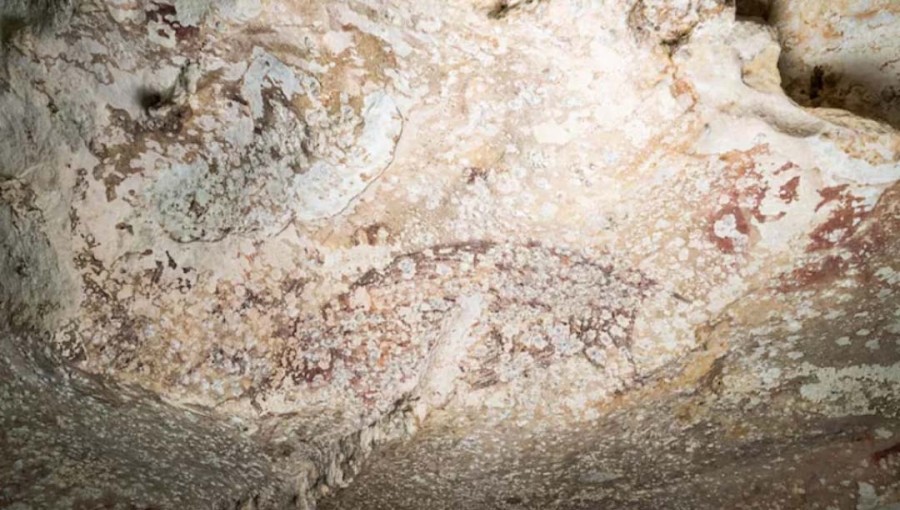What’s the oldest story ever recorded by humans? Scientists now think it’s a story as old as time — humanity’s place in nature — painted at the back of a cave in Indonesia.
It’s a scene of humans interacting with a pig, painted on a wall in red and black pigments; the flickering of torchlight makes the figures dance and leap, animating the scene into a story.
New analysis, published July 3 in the journal Nature, has found that this sophisticated scene of human-animal interactions is around 51,200 years old, making it tens of thousands of years older than other narrative cave art in places like Lascaux cave in France.
“We, as humans, define ourselves as a species that tells stories. These [paintings] are the oldest evidence of us doing that. It shows that the painters were conveying more information about images than just static images,” said Maxime Aubert, an archaeologist at Griffith University in Australia, who led the study.
Oldest narrative cave art found so far
Aubert’s team studied layers of art which cover the walls of a limestone cave called Leang Bulu Sipong 4 on the Indonesian island of Sulawesi.
Previous work at the cave showed homo sapiens, or modern humans, had revisited the cave over thousands of years, leaving their stories on the wall between 27,000 and 44,000 years ago.
The art is preserved behind a layer of calcium carbonate which formed over the cave wall over thousands of years — trapping the art like an insect in amber.
Previous dating techniques, called uranium-series dating, dated the oldest art at roughly 44,000 years old. But a new version of the method using a laser to sample the rock allowed a “more accurate and efficient” way to date the art, said Aubert.
The new method pushed the date of the cave art back by 4,000 years, to around 48,000 years ago.
Aubert’s team also used the method on a previously undated section of figurative art at the nearby cave of Leang Karampuang. The scene depicts humans interacting with a pig-like animal.
The analysis found the art to be 51,200 years old, making it the oldest narrative scene ever created by humans discovered to date.
50,000 years ago a ‘golden point’ of human evolution
The Indonesian cave art isn’t the oldest in the world, though — that title goes to cave art in Cueva de los Aviones in Spain.
But the art in the caves in Indonesia is much more sophisticated, said George Nash, an archaeologist at the University of Coimbra in Portugal, who was not involved in the study.
“The cave art in Spain is mostly handprints, but the cave art in Indonesia is much more sophisticated and likely contains more of a narrative. The question is: What the hell is going on in Sulawesi in Indonesia with sophisticated art being produced at this time? Very little art has been dated older than 50,000 years,” Nash told DW.
The 50,000-year threshold is seen by archaeologists as a “golden point” in human evolution, because it’s when “when more adventurous modern humans moved eastwards to Asia, into Indonesia, and into Australia, which back then was all connected by a giant landmass,” said Nash.
Other figurative art has also been found in the nearby island of Borneo, making the region a hot spot for ancient art.
Modern techniques of studying cave art, along with genetic analysis of ancient remains, have charted the spread of modern humans around the globe with remarkable accuracy.
Nash said the field had been very eurocentric just 10 years ago, but new, broader approaches are putting us “on the cusp of finding some wonderful things about the movement of homo sapiens across the globe and our relationships with Neanderthals.”
For example, Nash thinks interspecies relationships might have influenced human cave art. “Fifty thousand [years ago] is a melting pot where migrating humans and Neanderthals were learning from each other,” he said. “We don’t know what the discourse meant, but one result could have been more sophisticated art.”
Is it really narrative art?
The authors said their findings implied that homo sapiens developed a rich culture of storytelling in Indonesia far back in our evolution. The ancient artists composed scenes to tell visual stories about human–animal relationships.
While Joao Zilhao, an archaeologist at University of Lisbon, praised the methods of the study, he was more critical of the interpretation.
“The authors provide no evidence that the different things they dated form an integrated ensemble. ‘Narrative’ and ‘storytelling’ are to be found in Aubert et al.’s paper, not in the art itself,” he told DW via email.
Nash was more convinced that the cave art was narrative. “It’s like the symbol of a cross. Any Christian can form a complex narrative from a simple figurative design,” he said.
It’s the same in Australian Aboriginal art, he pointed out, where the very simplicity of an animal shape can tell a complex story.
While we have lost the meaning of the narrative for those humans 52,000 years ago — was it a hunting scene, or reverence of an animal?— Nash strongly suspects the art had ceremonial or ritual value because it was found at the back of the Indonesian caves, where storytelling likely took place.
“It’s intangible evidence, but it fits with using multiple approaches, like archaeology, anthropology and philosophy to understand the past,” he said.
Nash added that it’s a great thing Aubert’s team went back and re-analyzed cave art with more accurate dating methods, adding that more research needed to be done on rock art around the word.
“I bet we’d find art older than 60,000 years,” he said. “If so, it would entirely change our understanding of modern humans.”































Comment: